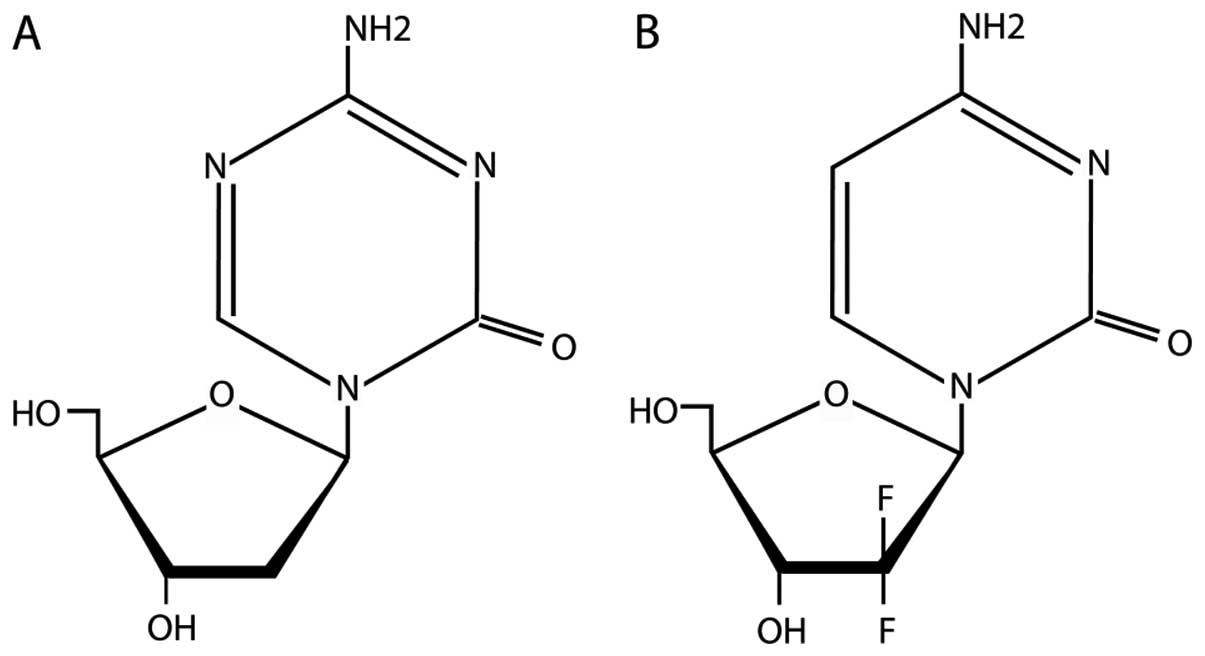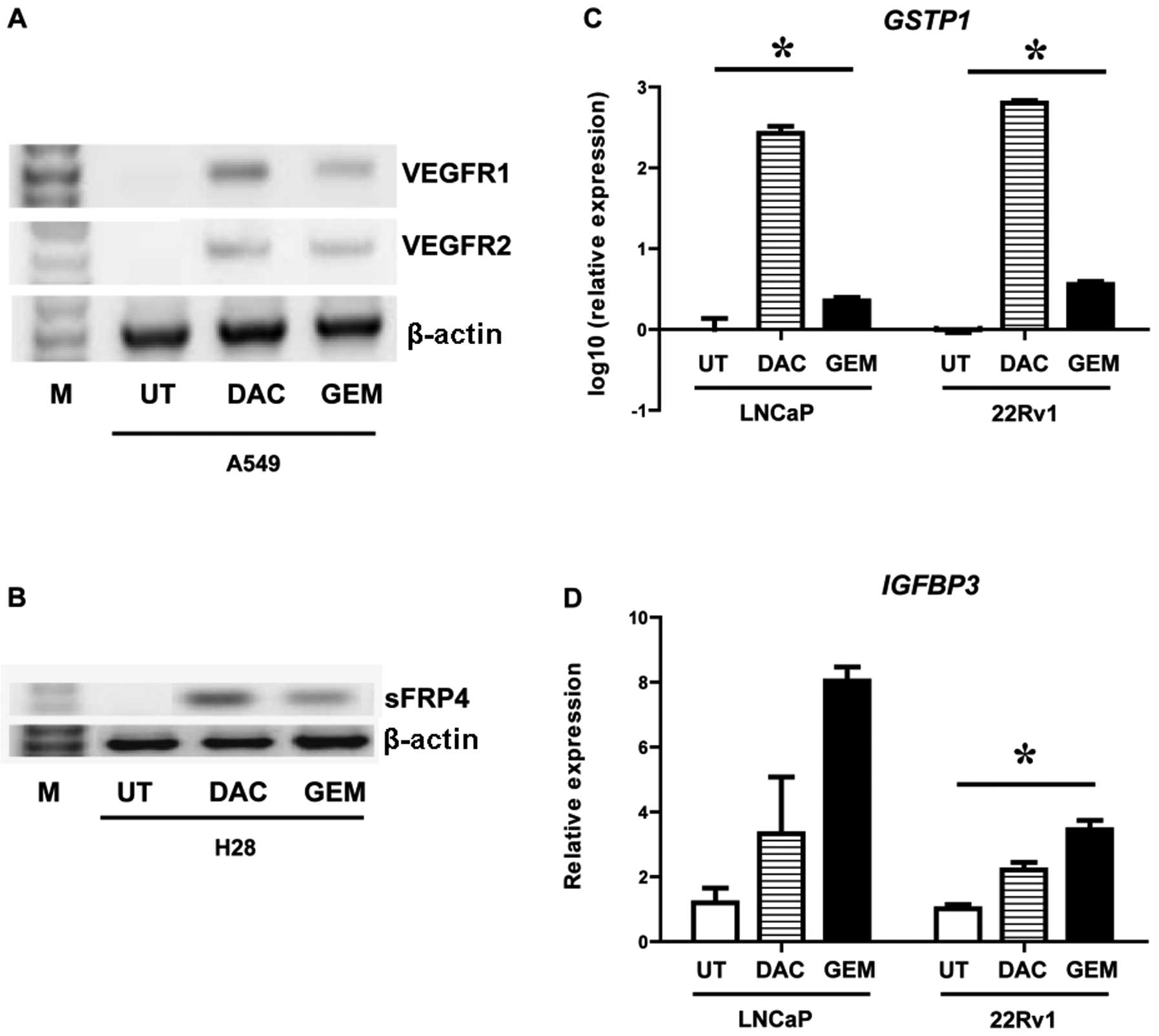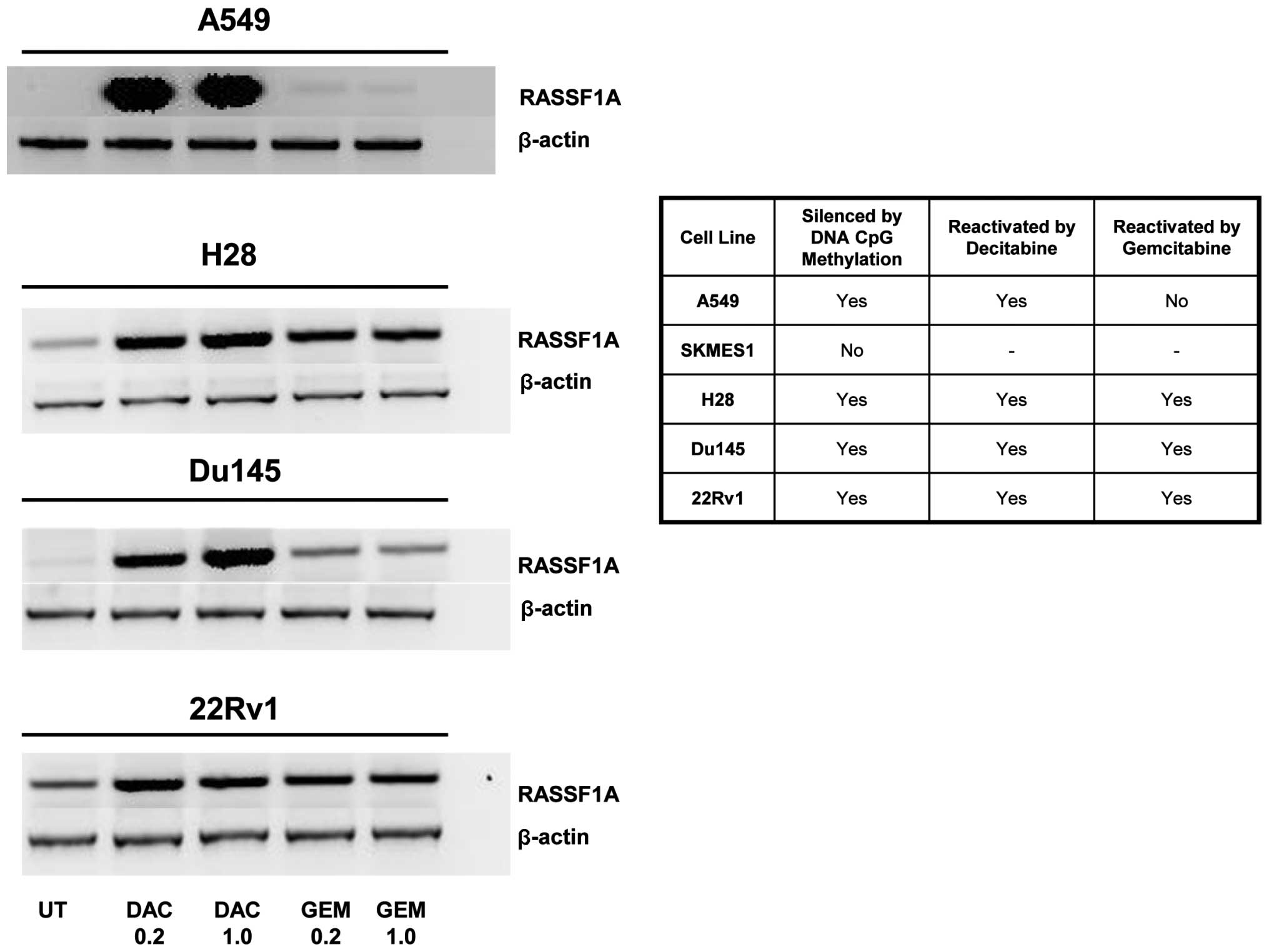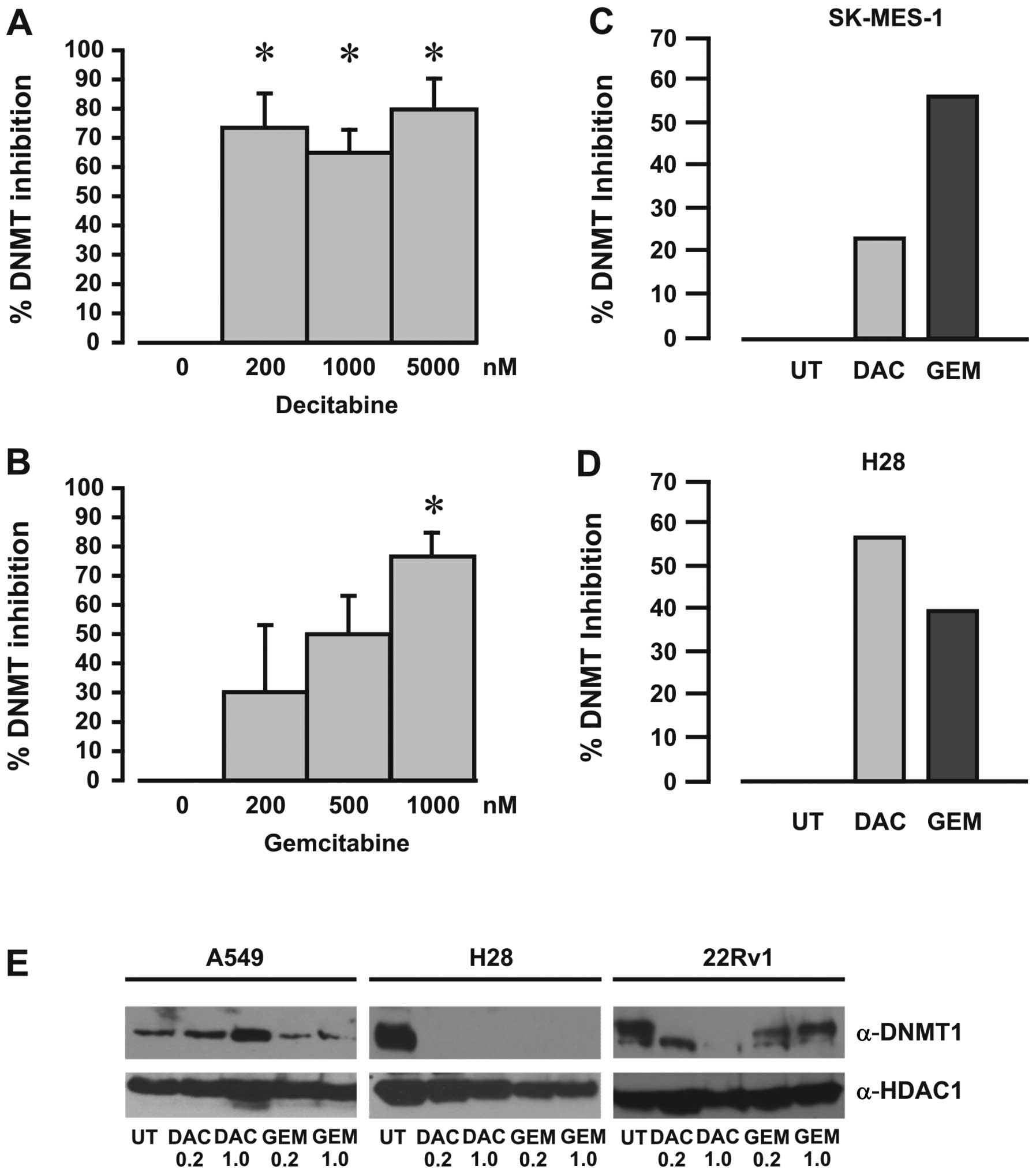Gemcitabine reactivates epigenetically silenced genes and functions as a DNA methyltransferase inhibitor
- Authors:
- Published online on: September 21, 2012 https://doi.org/10.3892/ijmm.2012.1138
- Pages: 1505-1511
Abstract
Introduction
Gemcitabine is a well-established anticancer agent and has been FDA approved either as a single agent for the treatment of pancreatic cancer (1) or in combination with another agent (carboplatin, cisplatin or paclitaxel) for the treatment of ovarian (2) and metastatic breast cancer (3). Cisplatin is indicated as first-line therapy for inoperable, locally advanced (stage IIIA or IIIB) or metastatic (stage IV) non-small cell lung cancer (NSCLC) (4,5), and has also been studied in other solid tumours such as malignant pleural mesothelioma (MPM) (6,7) and prostate cancer (8,9).
Gemcitabine is considered to act as a pyrimidine-type anti-metabolite. The agent is a prodrug and requires intracellular conversion to two active metabolites, gemcitabine diphosphate and gemcitabine triphosphate, which can function in two ways: by binding to and irreversibly inhibiting ribonucleotide reductase (RNR) and by replacing one of the building blocks of nucleic acids, in this case cytosine, during DNA replication (10).
Aberrant epigenetic regulation of gene expression is a frequent event in cancer (11). Several of the proteins which regulate histone post-translational modifications have now been shown to play a role in resistance to various cancer therapies including cisplatin (12), gefitinib (13), etoposide (14) and tamoxifen (15).
DNA CpG methylation is another epigenetic modification that is linked to loss of gene expression in cancer (16). Inhibitors targeting DNA methyltransferases have been developed. Of these 5-azacytidine (Vidaza®) and 5-aza-2-deoxycytidine (decitabine/Dacogen®) have gained FDA approval for the treatment of myelodysplastic syndrome subtypes (17,18).
Notably, the chemotherapy agent doxorubicin has been shown to inhibit the DNA methyltransferase DNMT1 (19) and indicates that other chemotherapy drugs may potentially inhibit the epigenetic enzymatic machinery. Since decitabine and gemcitabine are cytosine analogues, and share similar structural features (Fig. 1), we reasoned that gemcitabine may also be able to act as a DNA methyltransferase inhibitor (DNMTi).
Materials and methods
Cell lines
The A549 (adenocarcinoma), SKMES1 (squamous cell carcinoma), H-28 (MPM), 22Rv1 (prostate), LNCaP (prostate) and Du145 (prostate) cell lines were purchased from the ATCC (LGC Promochem). Cells were cultured in appropriate media and maintained at 37°C in a humidified atmosphere containing 5% CO2.
Cell line treatments
Decitabine was purchased from Merck and dissolved in methanol. Cell cultures were treated for 48 h at a final concentration of 5 μM, with the media and drug replaced every 24 h as previously described (20).
Gemcitabine was supplied by Eli Lilly and dissolved in phosphate-buffered saline (PBS) at a final concentration of 38 mg/ml (120.14 mM). Cell cultures were treated for 48 h at final concentrations of 0.2, 0.5 or 1 μM with the media and drug replaced every 24 h. We chose to use this concentration based on literature searches in Pubmed.
RNA isolation and RT-PCR amplification
Total RNA was extracted using TRI Reagent® (MRCgene) according to the manufacturer’s instructions. One microgram of total RNA was used to generate cDNA using M-MLV-reverse transcriptase (Promega) according to the manufacturer’s instructions.
Expression of VEGFR1, VEGFR2, sFRP4, RASSF1A and β-actin was examined by RT-PCR, using primers and PCR conditions outlined in Table I. Each PCR was carried out for 35 cycles. Ten microlitres of the experimental RT-PCR product and 2 μl of the β-actin RT-PCR product were loaded onto a 1% agarose gel.
Quantitative PCR
RNA was isolated from the cell lines using a miRVana miRNA isolation kit (Applied Biosystems, UK) according to the manufacturer’s guidelines. Total RNA (1 μg) was reverse transcribed using the high capacity cDNA Archive kit. Expression of GSTP1 (TaqMan® gene expression assay ID: Hs00168310_m1) and IGFBP3 (TaqMan gene expression assay ID: Hs00181211_m1) was quantified in the cell lines by qRT-PCR. Human phosphoglycerate kinase 1 (PGK1) was used as an endogenous control (TaqMan gene expression assay ID: Hs99999906_m1). TaqMan PCR reactions were performed in triplicate on an ABI Prism 7900 sequence detection system. Gene expression was calculated relative to the untreated cell lines, using SDS RQ Manager 1.2 software, which automatically determines relative quantities (RQ), by applying the arithmetic formula 2−ΔΔCT. All equipment and reagents were supplied by Applied Biosystems, Foster City, CA.
DNA methyltransferase assay
Analysis of DNA methyltransferase activity was carried out using the EpiQuik™ DNA methyltransferase activity/inhibition assay kit (Epigentek) using both recombinant DNMTs (Epigentek) and nuclear extracts isolated with the EpiQuik Nuclear Extraction kit II (Epigentek) according to the manufacturer’s instructions. Following consultation with the manufacturers, the recombinant proteins were incubated with the various concentrations of decitabine or gemcitabine for 90 min at room temperature prior to conducting the methyltransferase assay.
Genomic DNA isolation, bisulfite conversion and MS-PCR analysis
Genomic DNA was isolated from the cell lines using a solution containing 0.5% SDS and 100 μg/ml Proteinase K (21).
Genomic DNA from the cell lines (500 ng) was bisulfite modified using the EpiTect Bisulfite kit (Qiagen, UK), following the manufacturer’s guidelines. EpiTect methylated DNA and unmethylated DNA were used as controls.
Promoter hypermethylation of the GSTP1 promoter was analysed by methylation-specific PCR (MS-PCR) in the LNCaP and 22Rv1 cell lines using the GoTaq HotStart enzyme (Promega). PCR primer sets complementary to both modified, methylated DNA (M) and modified, unmethylated DNA (U) were designed for GSTP1: GSTP1 MF2, 5′-TTCGGGGGTGTA GCGGTCGTC-3′; GSTP1 MR1, 5′-CCAACGAAAACCTCGC GACCTCCG-3′ (expected product, 145 bp); GSTP1 UF2, 5′-GATGTTTGGGGTGTAGTGGTTGTT-3′; GSTP1 UR1, 5′-AAACTCCAACAAAAACCTCACAACCTCCA-3′ (expected product, 154 bp).
Bisulfite pyrosequencing
Pyrosequencing methylation analysis (PMA) of the LINE-1.2 element, the RASSF1A promoter and the VEGFR gene promoters, was performed as previously described (22–24). Genomic DNA (500–1,000 ng) was bisulfite treated, using the EpiTect Bisulfite kit or the EZ DNA Methylation™ kit (ZymoResearch). The PyroMarkAssay Design software was used to design the primers for amplification and sequencing to cover a number of CpG sites as shown in Table II. PCR amplification products were cleaned and subjected to pyrosequencing on either a PyroMark Q96 ID pyrosequencer using PyroMark Gold Q96 SQA reagents (all were from Qiagen), or on a Q24 pyrosequencer according to the manufacturer’s protocol (Biotage). The methylation of C in each analysed CpG site was quantified from 0 to 100%, using the PyroMark software (Qiagen).
Western blot analysis
Protein lysates were extracted from cell cultures using RIPA buffer [50 mM Tris HCl, pH 7.4, 150 mM NaCl, 1 mM EDTA, 1% (v/v) Triton X-100, 0.1% (w/v) SDS], supplemented with 10 μl phenylmethylsulfonyl fluoride (87 mg/ml in 96% EtOH) and 100 μl protease inhibitor cocktail (2 mM AEBSF, 1 mM EDTA, 130 μM bestatin, 14 μM E-64, 1 μM leupepin, 0.3 μM aprotinin). Lysates were separated by SDS/PAGE and subsequently transferred onto pre-activated polyvinylidene fluoride nitrocellulose membranes (PVDF). Membranes were blocked for 1 h at room temperature (RT) in TBST [10 mM Tris-HCl (pH 7.5), 10 mM NaCl, 0.1% (v/v) Tween 20] containing 5% nonfat dry milk powder. Membranes were immunoblotted overnight at 4°C in TBST with 5% nonfat dry milk powder with DNMT1 (supplier) with HDAC1 (Cell Signalling Technologies) used as a loading control as appropriate. All secondary antibodies were HRP-labelled and bound antibody complexes were detected using the Supersignal West Pico Chemiluminescent kit (Pierce, Rockford, IL, USA).
Results
Gemcitabine reactives mRNA expression of epigenetically silenced genes
A549 (NSCLC), H28 (MPM), LNCaP (prostate) and 22Rv1 (prostate) cells were treated with either decitabine or gemcitabine and the effects of these drugs on gene expression were examined. In A549 cells decitabine and gemcitabine induced both VEGFR1 and VEGFR2 (Fig. 2A). In the H28 cell line a gene previously shown to be epigenetically silenced in this cell line by DNA CpG methylation (25,26), sFRP4, was reactivated by both drugs (Fig. 2B). Both GSTP1 and IGFBP3 have been shown to be epigenetically silenced by DNA CpG methylation in prostate cancer by us and others (27–29). Using quantitative PCR we measured the effect of decitabine and gemcitabine on these genes in two prostate cancer cell lines (LNCaP and 22Rv1). Both drugs were shown to significantly induce expression of GSTP1 (Fig. 2C) and IGFBP3 (Fig. 2D).
As all these genes were examined separately in different cell lines we reviewed the literature to find whether there was a common gene frequently silenced by DNA CpG methylation in lung, MPM and prostate cell lines. From this analysis we chose the gene RASSF1A which was shown to be silenced by methylation in several of our cell lines (30–32). Gemcitabine was able to reactivate/upregulate RASSF1A in 3 out of the 4 cell lines tested whereas decitabine reactived RASSF1A in 4 out of the 4 cell lines at all concentrations tested (Fig. 3).
Decitabine functions in vitro and in vivo to inhibit DNA methyltransferases
A DNA methyltransferase activity/inhibition assay was used to measure the effects of gemcitabine on DNMT enzymatic activity, with decitabine used as a positive inhibitor control. Using recombinant DNMT protein mixture we demonstrated that both decitabine and gemcitabine inhibited DNMT activity (Fig. 4A and B). Furthermore, DNMT activity was also inhibited in nuclear extracts from cells exposed to either decitabine or gemcitabine (Fig. 4C and D), indicating that gemcitabine inhibits DNA methyltransferase activity.
Gemcitabine affects DNMT1 protein stability
Decitabine has been shown to selectively degrade DNMT1 protein levels by a proteasomal-based pathway (33). To examine whether gemcitabine also affects the levels of DNMT1 protein, western blot analyses were carried out on extracts from cells treated with various concentrations of gemcitabine or decitabine. Gemcitabine was found to affect DNMT1 protein levels to different degrees for all the cell lines examined (Fig. 4E).
Gemcitabine does not alter global DNA CpG methylation or at the promoters of reactivated genes
Schafer and colleagues published data demonstrating that gemcitabine affects DNA methylation in cancer cells by inhibiting nucleotide excision repair (NER)-mediated DNA demethylation. Intriguingly, the authors showed that gemcitabine treatments did not affect global levels of DNA methylation but induced hypermethylation and silencing of MLH1 (34).
Using pyrosequencing of long interspersed nucleotide element (LINE-1) sequences, we examined global methylation in our cell lines. In agreement with Schafer et al (34), we did not observe any gross alterations in the global DNA CpG methylation following treatment with gemcitabine (Table III). For the lower concentration of decitabine tested (0.2 μM) we noted a decrease in CpG methylation which did not occur in the cells treated at the higher concentration (1 μM) in agreement with effects reported by others (35).
Next, we examined the effect of decitabine and gemcitabine on CpG methylation within RASSF1A. Again decitabine caused alterations to DNA CpG methylation levels at the lower concentration, yet there was no effect on methylation at the higher concentration (Table III). For the most part gemcitabine did not alter DNA CpG methylation for either concentration examined (Table III). Similar results were observed for VEGFR1 (data not shown).
GSTP1 has been previously shown to be downregulated by DNA CpG methylation (27–29). Given that we were able to demonstrate that both gemcitabine and decitabine reactivated the expression of GSTP1 in prostate cancer cell lines (Fig. 2), using MS-PCR, we examined whether or not there is a loss of methylation at the GSTP1 promoter in the 22Rv1 cell line. Our results showed a clear increase in the levels of unmethylated DNA at the GSTP1 promoter following treatment with either drug, indicating that there may be some changes to DNA CpG methylation occurring in cells treated with gemcitabine (Fig. 5).
Discussion
Gemcitabine is a well-established chemotherapy agent used as a single-agent treatment in pancreatic cancer, or in combination with various other agents in the treatment of many solid tumours. Its mode of action is generally considered to be that of an anti-metabolite acting to either inhibit ribonucleotide reductase (RNR) or by replacing cytidine during DNA replication.
Aberrant epigenetic regulation through DNA CpG methylation is a frequent event in cancer and reactivation of the target of methylation induced silencing 1 (TMS1) by DNA methyltransferase inhibitors (DNMTi) was found to enhance sensitivity to gemcitabine in pancreatic cancer cells (36).
We noted that gemcitabine shares structural similarity with the FDA-approved DNMTi decitabine (Dacogen) (Fig. 1) and tested whether or not it has the ability to affect DNA CpG methylation. We showed that gemcitabine actively induces expression of epigenetically silenced genes in lung, mesothelioma (MPM) and prostate cancer cell lines (Figs. 2 and 3). We showed that gemcitabine directly inhibits DNA methyltransferases (Fig. 4). In addition, we also showed that gemcitabine depletes levels of DNMT1 similar to decitabine (Fig. 4). However, despite gemcitabine’s ability to inhibit DNMTs, alter cellular DNMT1 protein levels and reactivate epigenetically silenced genes, there were few if any changes to DNA CpG methylation levels. We provide some evidence that active demethylation of an epigenetically silenced gene can occur (Fig. 5), but another mechanism may have to be invoked.
Schafer et al (34) published additional data demonstrating that gemcitabine affects DNA methylation in cancer cells by inhibiting nucleotide excision repair (NER)-mediated DNA demethylation. The authors showed that gemcitabine treatments did not affect global levels of DNA methylation but induced hypermethylation and silencing of MLH1 (34). In agreement with the authors we also found that global levels of DNA CpG methylation were unaffected. In addition, methylation at the promoters of genes which could be reactivated following treatments with either decitabine or gemcitabine did not demonstrate any major changes in methylation status. This may in part be due to the concentrations of drugs used. For example, it has been established that high concentrations of decitabine have less effect on DNA methylation due to cytostatic effects, and our results using pyrosequencing confirm this demonstrating that changes in DNA methylation only occurred at the lower concentration of drug used (Table III). Using MTT assays we examined cellular proliferation across a range of concentrations (decitabine 200–5,000 nM; gemcitabine 50–1,000 nM) in A549 and SKMES1 cells. While decitabine did not affect cellular proliferation to any appreciable effect at any concentration, gemcitabine caused significant decreases (of the order 25–50%) in cellular proliferation (data not shown), which was not unexpected given the other known mechanisms of action of this drug.
Schafer et al (34) used a range of concentrations (34, 67 or 134 nM), whereas we used higher concentrations (0.2–1 μM). It must be noted, however, that in gemcitabine infusion studies of patients with solid tumours, blood concentrations of gemcitabine at Day 1 of infusion varied between 18 and 77 μM and at Day 15 between 13 and 90 μM (37). As such the amount of gemcitabine used in our analysis was still below the levels utilised in patients.
The concentration of gemcitabine may become a critical determinant in how this chemotherapeutic agent is used in the clinic. For instance, in a study using MPM cells, gemcitabine inhibited the secretion of the proinflammatory cytokine IL-6 at drug concentrations that produced only small decreases in cell viability, whereas at higher doses a surge of IL-6 release was noted (38). We also observed an increase in the protumourigenic cytokine IL-23 in a NSCLC cell line treated with gemcitabine (Gray and O’Byrne, unpublished data).
How then does gemcitabine induce or reactivate epigenetically silenced genes. The nitrogen substitution of carbon 5 in the cytosine ring (Fig. 1) is involved in the mechanism of DNMT inactivation. As this nitrogen is not present in gemcitabine it may be that some sort of steric hindrance is involved affecting DNMTs and or methyl-binding proteins. Conceivably by inhibiting binding of methyl-binding protein complexes to DNA CpG sites this may relax chromatin and result in the re-expression of silenced genes.
The results presented by us and Schafer et al (34) demonstrate a novel indication for gemcitabine and may have important implications in oncology as DNA methylation effects are potentially useful as biomarkers to either monitor response to therapy (39), or may have predictive value (40). In particular, the ability of gemcitabine to reactivate epigenetically silenced genes indicates a potential means to monitor and identify those patients who actually respond to gemcitabine treatment.
There are exciting new avenues which could be exploited, for example the use of low dose gemcitabine regimens combined with other epigenetic targeting drugs such histone deacetylase inhibitors. In addition low dose regimens may have the ability to sensitise resistant cancer to other cancer therapies. Further study will be required to fully delineate these possibilities.
Acknowledgements
Funding support for this project was provided by the Irish Cancer Society to Antoinette Perry.














